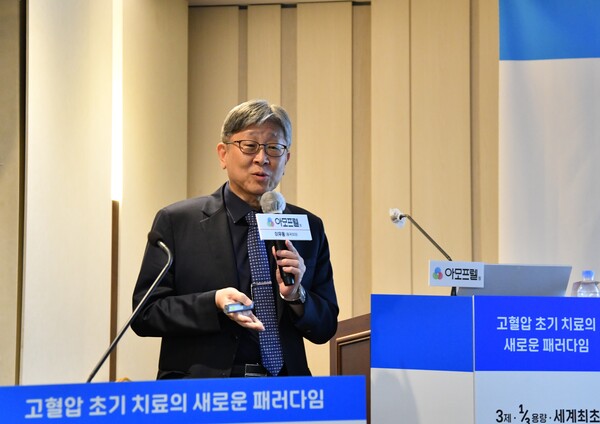Amoprel (amlodipine 1.67mg, losartan 16.7mg, and chlorthalidone 4.17mg), the world's first commercially available low-dose triple-combination hypertension medication, has taken center stage in shifting the paradigm of hypertension treatment both at home and abroad.
Hanmi Pharmaceutical held a news conference on Wednesday titled “Amoprel: A New Paradigm in Hypertension Treatment.”
At this event, Hanmi presented a treatment option that “actively controls blood pressure from the initial therapy stage” through seven years of large-scale clinical development and collaboration with the Ministry of Food and Drug Safety. The company expressed confidence that Amoprel will serve as a game changer in the management of early-stage hypertension patients, citing its rapid blood pressure reduction, low incidence of side effects, and convenient dosing regimen.

Investment of 12 billion won over 7 years led to 1st approval worldwide
Amoprel is the world's first low-dose triple-combination therapy, combining amlodipine, losartan, and chlorthalidone at one-third of the standard dosage. Hanmi Pharmaceutical initiated development in 2018 and conducted five clinical trials, spanning phases 1 to 3. This process involved over 12 billion won ($8.6 million) in costs and the participation of about 200 development personnel.
Phase 3 study results demonstrated Amoprel's superiority, lowering systolic blood pressure by an average of 3.8 to 4.0 mmHg more than 50mg losartan, while confirming non-inferiority compared to 5mg amlodipine. Notably, in the female patient group, the blood pressure-lowering effect was on average 5.7 mmHg greater than that of losartan. Regarding side effects, the incidence of peripheral edema—commonly seen with amlodipine monotherapy—was statistically significantly lower. Amlodipine is one of the most widely used drugs in the treatment of hypertension in Korea.
The world-first development of Amoprel is notable for its position ahead of global and therapeutic trends. Recently, academic circles have seen a growing movement to utilize low-dose multi-drug combinations as initial treatment options in hypertension management. Indeed, the U.S. Food and Drug Administration (FDA) approved George Medison's low-dose triple combination Widaplik in June 2025, and pharmaceutical companies in China and Korea are also developing similar products.
The European Society of Hypertension (ESH) 2023 guidelines also recommend “improving blood pressure control and tolerability through ultra-low-dose combination therapy.” The domestic launch of Amoprel, approved in Korea this May, aligns with this international trend and can even be considered ahead of it.
Signals a shift in treatment strategy: reduce edema and further reduce blood pressure

An intriguing point is that the impetus for Amoprel's development came from Korean medical professionals. The key figure is Professor Rhee Moo-yong of the Department of Cardiology at Dongguk University Ilsan Hospital.
Professor Rhee said, "When I encountered research on low-dose triple combination therapy at the European Society of Cardiology in 2017, I became convinced that 'the paradigm for hypertension treatment must change.” Instead of the traditional stepwise approach of gradually increasing medication, he believed achieving rapid blood pressure control required simultaneously blocking three mechanisms from the outset. That day, I called Hanmi Pharmaceutical's development team to propose the project, and a long journey spanning seven years began, leading us to where we are today.”
Professor Rhee subsequently led the phase 2 and 3 clinical trials as the principal investigator for Amoprel.
“Amoprel demonstrated superiority over losartan 50mg and non-inferiority to amlodipine 5mg. Notably, it achieved a greater reduction in blood pressure in female patients, significantly reduced side effects like peripheral edema, and had a high rate of patients reaching their target blood pressure,” he said. “This makes us hopeful for improved treatment adherence.”
Professor Lee emphasized that Amoprel is optimal for patients with mild to moderate hypertension requiring active blood pressure control in the early stages.
“Its small tablet size enhances medication adherence, and it offers the advantage of starting patients directly on a combination therapy rather than a single agent. It will be a good choice, especially for female and younger patients who are sensitive to side effects,” Professor Rhee said.
Hanmi Pharmaceutical plans to leverage this clinical evidence to advocate for Amoprel's inclusion in Korean and international guidelines for hypertension treatment.

Park Myung-hee, Executive Vice President of Hanmi Pharmaceutical's Domestic Business Division, stated, “Amoprel is the only combination therapy to have obtained an initial therapy label,” adding, “It serves as a useful alternative to ARB/CCB monotherapies, and we plan to lead research for domestic and international guidelines.”
The number of hypertension patients in Korea totals about 13 million, increasing by 450,000 annually. Considering that awareness and treatment rates among those in their 20s and 30s remain in the 30 percent range, Amoprel, with its focus on medication convenience and reduced side effects, is expected to contribute to attracting younger patient groups. The drug price is 593 won, about 10 percent cheaper than existing high-dose ARBs and about 20 percent cheaper than ARB-CCB combination drugs.
Related articles
- Hanmi rolls out low-dose triple combo drug for hypertension
- Hanmi’s Q1 earnings hit by China slump but exports up 47% with new hypertension launch on deck
- Hanmi Pharm files phase 3 IND for GLP-1 combo in type 2 diabetes
- Hanmi Pharm files FDA IND for obesity drug that targets fat loss and muscle gain
- Hanmi Science and Hanmi Pharmaceutical get ‘AA-’ rating from NICE

